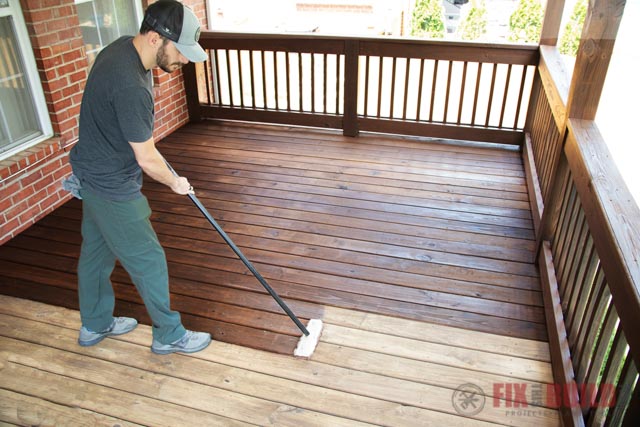Crafting Aesthetic Limits: The Magic of Fence Staining
Selecting the Right Stain for Your Fencing: Tips and Considerations
When it comes to preserving and boosting the look of your fencing, picking the appropriate tarnish is important. We will certainly discover the various kinds of fencing stains, elements to consider before selecting a tarnish, tips for preparing your fencing for discoloration, and the differences between water-based and oil-based stains. Additionally, we will delve right into picking the best stain color to enhance your fencing and boost your outdoor space.
Understanding Different Types of Fencing Discolorations

On the other hand, water-based stains are made from acrylic or latex and use an extra subtle shade to the timber. They develop a protective film externally of the timber, avoiding wetness from leaking in and safeguarding against UV damages. Water-based spots are less complicated to clean up and have a faster drying time contrasted to oil-based stains. They are likewise less likely to fade or crack gradually.
Selecting in between water-based and oil-based stains relies on different factors, consisting of personal preference, the desired appearance, and the degree of upkeep required. Oil-based spots are suggested for surround high-traffic areas or those constantly exposed to extreme weather problems. deck staining. Water-based stains, on the various other hand, are a prominent option for fence suburbs where appearance and convenience of usage are crucial
Comprehending the differences between water-based and oil-based discolorations assists property owners make a notified decision when picking the ideal discolor for their fencing. Considering the particular needs of the fencing, such as its location, direct exposure to sunlight, and wanted visual, will ensure that the selected stain supplies lasting defense and boosts the overall elegance of the fence.
Variables to Think About Before Picking a Spot

Various types of wood take in discolorations in a different way, resulting in varying levels of shade intensity and resilience. Additionally, specific timbers may be extra susceptible to concerns like rot or insect invasion, which might affect the choice of discolor to maintain the fencing and safeguard.
The environment and climate condition in your area must additionally be taken into account. You might require a tarnish that provides extra protection against moisture and UV rays if you live in an area with severe winters months or high moisture. Likewise, if your fence is exposed to direct sunlight for lengthy durations, a tarnish with UV inhibitors can aid prevent fading and discoloration.
Last but not least, it is essential to consider your wanted visual. Different spots provide different colors and finishes, permitting you to tailor the appearance of your fence (fence staining). Think about the overall design and style of your property, in addition to any type of local regulations or house owner organization guidelines that might dictate the appropriate discolor colors
Tips for Readying Your Fence for Staining
To prepare your fencing for staining, beginning by extensively cleansing the surface area using a mild cleaning agent and a pressure washing machine or scrub brush. Cleansing the fence is an important action as it removes dust, grime, and any previous coverings that might interfere with the discoloration process. Begin by moistening the fence with water and then use a light cleaning agent using a scrub brush or a stress washing machine with a low-pressure setup. Scrub the surface area carefully, paying additional focus to areas with persistent stains or mold and mildew. Wash the fence extensively with clean water to get rid of all traces of detergent.
After cleaning, enable the fencing to dry entirely. fence staining and sealing. This step is essential as discoloring a wet or moist surface area can bring about poor bond and an irregular coating. Depending on the climate condition, it may take anywhere from a few hours to a few days for the fencing to completely dry extensively. Ensure that the fencing is entirely dry before waging the staining process.
Before staining, inspect the fencing for any type of problems, such as loosened boards or nails. Repair any type of issues to guarantee that the fence is structurally sound. Furthermore, think about using a wood conditioner or brightener to the surface. This product assists to open up the wood pores, enabling the stain to penetrate better and uniformly.

Comparing Water-Based and oil-based Discolorations
When selecting a discolor for your fencing, it is very important to compare the attributes and advantages of oil-based and water-based spots. Both kinds of discolorations have their own advantages and considerations, so it is essential to understand the differences between them.
Oil-based spots are known for their toughness and resistance to wear and tear. They permeate deeply right into the timber, providing outstanding security against the aspects. They additionally improve the all-natural appeal of the timber by highlighting its grain and appearance. Additionally, oil-based discolorations have a tendency to last longer than water-based spots, making them a popular option for fencings.
On the other hand, water-based spots are much more environmentally pleasant and much easier to clean up. They might not offer the exact same level of defense as oil-based spots, especially in rough weather problems.
Eventually, the choice in between water-based and oil-based stains relies on your certain needs and choices. Think about elements such as sturdiness, environmental effect, and ease of application when making your choice. Consulting with a professional or looking for suggestions from specialists can likewise aid ensure that you pick the right tarnish for your fencing.
Selecting the Right Discoloration Color for Your Fence
The option of a suitable tarnish shade for your fencing is an important facet of enhancing its visual allure and complementing the total style of your exterior space (fence staining nashville tn). The best stain shade can transform a plain, common fencing right into a striking focal point that includes depth and personality to your property
When selecting a stain shade for your fencing, it is very important to consider the design and design of your home. Natural tones such as neutrals and browns can produce great site a cozy and welcoming look if you have a traditional or standard design home. On the other hand, if you have a modern-day or contemporary home, you may think about selecting bold and lively shades that make a statement.
One more aspect to take into consideration is the natural environments of your building. If you have a great deal of greenery, a discolor shade that complements the all-natural landscape, such as greens or crimsons, can produce a unified and natural look.
Additionally, it deserves thinking about the upkeep required for various tarnish shades. Lighter shades tend to show dirt and wear more easily, while darker colors can hide blemishes and require less frequent touch-ups.
Ultimately, the choice of stain color for your fence need to mirror your individual design and choices - deck staining companies near me. Make the effort to explore different alternatives and speak with with specialists if required, to ensure that you choose the best tarnish color that improves the charm and charm of your fencing
Final Thought
To conclude, when it concerns selecting the appropriate stain for your fence, it is essential to recognize the different types of spots offered and take into consideration factors such as toughness and wanted look. Preparing the fencing effectively prior to discoloration is critical for attaining optimal outcomes. Additionally, comparing water-based and oil-based discolorations can aid determine the best option for your specific needs. Lastly, choosing the ideal discolor color can improve the general visual appeals of your fence.
We will check out the various types of fencing stains, aspects to think about before selecting a discolor, ideas for preparing your fencing for staining, and the differences in between oil-based and water-based spots.Distinguishing between oil-based and water-based stains is essential when understanding various types of fence spots. Water-based discolorations are much easier to cleanse up and have a faster drying out time compared to oil-based spots. Furthermore, oil-based stains tend to last longer than water-based discolorations, making them a preferred option for fences.
In conclusion, when it comes to choosing the right discolor for your fence, it is vital to comprehend the various kinds of stains offered and consider variables such as sturdiness and wanted appearance.